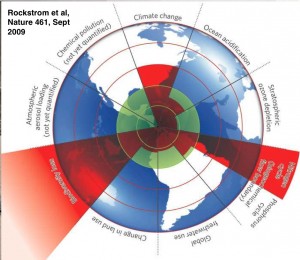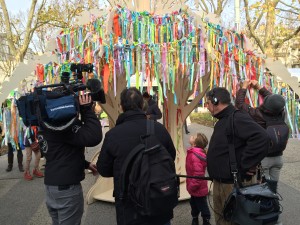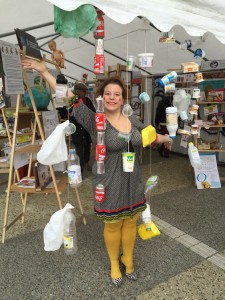
Almost 1000 people participated in Climate Reality training, March 1-4 in Denver. Click on photo to enlarge it.
Ten years ago when An Inconvenient Truth came out, I like so many other people became aware of the climate crisis. The movie ended with 10 things each of us could do to help stop global warming, and I did all of them: changed my light bulbs, took shorter showers, started recycling.
Yet now the climate crisis is worse than ever. Each of the last three years has been the hottest on record. Carbon dioxide in the atmosphere is at its highest point since the age of the dinosaurs. Oceans are 30 percent more acidic than before the Industrial Revolution, the fastest chemistry change in 50 million years. Glaciers worldwide are melting, the jet stream is wobbling, and ocean currents are slowing down.

I was lucky to get this pic with Al Gore at the Cedar Rapids airport in May 2015. No he doesn’t fly around on private jets. Photo by Brian Ettling
Clearly individual action is not enough. So two years ago, I attended my first Climate Reality training with Al Gore in Cedar Rapids, Iowa, to find out what else I could do. There I met hundreds of climate leaders from around the world and started learning about climate in depth.
Here are some mind-blowing facts:
- The energy trapped by man-made global warming pollution is now equivalent to exploding 400,000 Hiroshima atomic bombs per day, 365 days a year.
- Extreme hot days are now 150 times more common than 30 years ago.
- 2016 was the 40th consecutive year with a global temperature above the 20th century average.
- 93 percent of the extra heat trapped by manmade global warming pollution goes into the oceans.
- Seven 1,000-year floods have occurred in the United States in the last seven years.
- A 1ºC mean temperature rise decreases wheat yields by 21 percent.
- Water scarcity now affects 40 percent of the world’s population.
- Air pollution kills 6.5 million people worldwide every year.
- Land-based plant and animal species are moving poleward at a rate of 15 feet per day.
- We have lost more than half of the world’s wildlife in the last 40 years.
Climate action
I came out of the Iowa training determined to tackle the problem of climate change in a much more systematic way, through action on the local, state and national level. The first thing I did was join the Sierra Club, which helped me get to the People’s Climate March, testify about the Clean Power Plan, and lobby my state legislators on returning Ohio’s clean energy standards.
In December 2015 I went to Paris for two weeks as part of the Sierra Club delegation during the COP 21 climate conference. At the time, no climate agreement had included developing countries, and no one knew if almost 200 nations would come together to make it happen. But they did, and I came back full of hope that the climate crisis would finally be addressed.
A year later, after the 2016 election, I knew I had to get back to climate activism. In January, Climate Reality announced a new training in Denver, so I applied to go – this time not as a participant but a mentor. I was thrilled to be accepted and get 20 mentees from Ohio and California.
At mentor training the day before the conference, I learned that 2,700 people had applied for 900 slots. My list of mentees was full of accomplished people – among them, a city councilwoman from Cuyahoga Falls, a county commissioner from San Jose, a staffer for Ohio EPA, a former staffer for Florida Department of Transportation who left for a job at Google after the governor told employees they couldn’t discuss climate change, a doctor at Nationwide Children’s Hospital, and a high-school student from Marin School of Environmental Leadership.
Day 1

Xiuhtezcatl Martinez and Isa Caress performed their new song “Break Free” at Climate Reality conference in Denver. Photo by Jill MacIntyre Witt
On the first day we saw Al Gore give his entire slideshow, “The Climate Crisis and Its Solutions,” based on his presentation from An Inconvenient Truth. Gore updates this slideshow constantly, with many slides containing graphics and videos from recent events. This was followed by a panel discussion on responding to the impacts of climate change, featuring first responders, emergency managers, and community leaders on the front lines in Colorado.
Only the first half of Gore’s presentation is about the problem of climate change. If it stopped there, we would have been left hopeless, but it didn’t. The second half covered the incredible takeoff of renewable technologies. Here are a few facts:
- In 2016, $58.6 billion was invested in clean energy in the United States.
- Wind energy capacity has grown 16 times faster than 2000 projections.
- The United States now has 75 gigawatts of wind power installed, enough to power 20 million homes.
- Globally there is enough wind energy to supply electricity consumption 40 times over.
- Solar energy capacity has grown 77 times faster than 2000 projections.
- The cost of solar cells has fallen from $79.40 per watt in 1976 to 41 cents per watt now.
- Solar installation has gone from 4 megawatts in 2000 to 35,800 megawatts now.
- Enough solar energy hits the earth every hour to fill the world’s energy needs for a year.
- Renewables accounted for 90 percent of new electricity generation worldwide in 2015.
- The subsidy-free cost of solar and wind is now less than gas, coal or nuclear.
We also heard from Leah Greenberg, co-author of Indivisible, a guide by former Congressional staffers of best practices for making your elected representatives listen. The day ended with a performance by Xiuhtezcatl Martinez and his sister Isa Caress, indigenous hip hop artists. Xiuhtezcatl is also a plaintiff in the Our Children’s Trust lawsuit of 21 children against the federal government for not fulfilling its public trust to protect the climate for future generations.
Day 2
Day 2 featured an incredible panel of scientists including Kevin Trenberth, climate scientist with NOAA; Henry Pollack, geophysicist at University of Michigan; and Don Henry, director of Climate Reality in Australia.
They talked about the impacts of various types of greenhouse gases, the most prevalent denier claims and how to respond (check out Skeptical Science), political forces aligned against climate action (see Merchants of Doubt), the Montreal Protocol that phased out ozone-destroying CFCs as a model for climate action, how to get coal country on board (clean energy jobs), and the outlook for carbon capture and sequestration (too expensive for coal plants to implement), nuclear (too slow and expensive for our needs), and fracking (methane leakage and risks to water make it untenable, and we should just leapfrog to renewables).
We also heard about best practices for communicating climate change from Ngiste Abebe of Aulenor Consulting, and Jon Shenk and Diane Weyermann of Participant Media, who talked with Al Gore about making An Inconvenient Sequel: Truth To Power, which premieres July 28.
Day 3
Day 3 began with a survey of the political landscape after the election of Trump by Ken Berlin, president of the Climate Reality Project. One point Berlin made is that Trump can’t just roll back climate rules or even agency budgets without new rules and action from Congress, and that environmental activists and groups will be fighting his anti-climate agenda every step of the way.
We heard from Director of Engagement Olena Alec about what we as climate leaders could do, with slides of actions by current climate leaders, including two people I had trained with in Iowa, Doug Grandt presenting to a room of fifth-graders and Ina Warren conducting a monarch workshop.

Al Gore recognizes leaders of cities and universities that have committed to going 100% renewable. Photo by Bill Trueit.
Gore then presented awards to representatives of several cities that have recently committed to transitioning to 100 percent renewable energy. Climate Reality’s 100% Committed campaign is working with Sierra Club’s Ready for 100 campaign to bring on dozens of new cities by 2018. Stay tuned – this could be coming soon to a city near you.
Next was a presentation by Jules Kortenhorst, CEO of the Rocky Mountain Institute, that explained both the technology and economics behind the unstoppable rise of renewable energy over expensive, outdated and polluting fossil fuels, followed by a livestreamed panel of Climate Reality leaders talking with Al Gore about their experiences.

Mentees at the very first training in Al Gore’s barn in 2006 for what was then called the Climate Project. Photo by Keith Bergman.
Over lunch the mentors got to meet Al Gore in person. I had gotten my photo with Gore at the Iowa training in 2015 – purely by luck meeting him at the airport – so this time I took photos for other people. Some of the other first-time mentors were thrilled, while the longtime mentors caught Gore up on their latest news. Two mentors in Denver, Keith Bergman and Bill Bradbury, had been among 50 people at the very first training in 2006 at Gore’s barn in Carthage, Tenn.
The afternoon was filled with breakout sessions on topics like public lands, the water/energy nexus, putting on sustainable events, but after an intensive four days of training, I took a couple of hours for myself before commencement at which I gave certificates and Green Rings to my mentees. I’ll be following up with them throughout the year, hoping to arrange a meetup for the Ohio mentees this summer. We now have at least a dozen Climate Reality leaders in the state.
Moral challenge

The last day of Climate Reality training in Denver. My tables were in the back of the room that day.
Al Gore’s closing remarks to the conference summed up why I’m in the climate movement. Climate change, he said, is a moral challenge in the tradition of other moral issues of our time such as abolitionism, women’s suffrage, civil rights, apartheid, and most recently gay marriage. These movements encounter roadblock after roadblock, until finally they succeed.
“When any great moral challenge is resolved into a binary choice between what is right and what is wrong, the outcome is foreordained because of who we are as human beings,” Gore said. “That is where we are now, and that is why we are going to win this. We have everything we need. Some still doubt we have the will to act, but I say the will to act is itself a renewable resource.”
The Climate Reality Project has now held 35 trainings for over 11,000 climate leaders from around the world, and they are still going strong. This is a unique opportunity to learn about the most pressing crisis facing the planet, and how to make change even in a hostile political environment. It’s also a chance to meet some amazing people you will be in contact with for years. If you are concerned about climate change, this is a program you won’t want to miss.
This article appeared in the April 2017 newsletter for Sierra Club Central Ohio Group.









